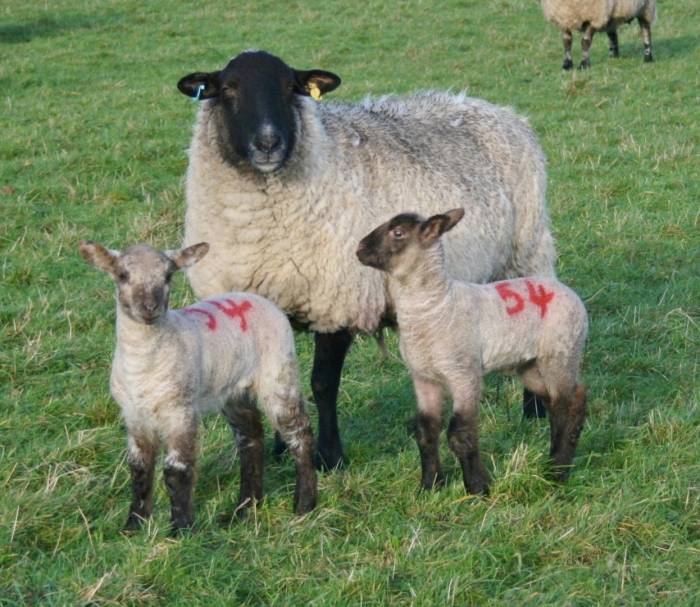Worming ewes around lambing remains a common practice in UK flocks, but whole flock treatments are costly, time consuming and add to the speed with which worms develop resistance to wormers. To address this the Sustainable Control of Parasites in Sheep (SCOPS) group, an industry body providing best-practice advice, is urging producers to consider carefully which ewes need to be treated around lambing this year.
Speaking on behalf of SCOPS, Lesley Stubbings says: “Most sheep farmers are now aware over-use of wormers is a major factor in the development of resistance. Along with antibiotics, we are all being urged to think carefully about how and when we use these important medicines, using them only when necessary and avoiding blanket treatment across flocks. And yet, many are still routinely worming all their ewes, often with persistent products.”
To help sheep farmers decide which ewes to treat, SCOPS has issued a five-question check list to help farmers and their animal health advisors understand the background to worming at lambing and apply it to their individual flocks.
- Why do we treat ewes? The rationale behind treating ewes is that it reduces the number of worm eggs a ewe puts onto pasture when her immune system relaxes around lambing. Along with larvae that have overwintered, this will be the source of the worms that will challenge lambs later in the season. So, if we can differentiate between the ewes that put out the most eggs from those that shed the least, we can treat selectively.
- Which ewes do we need to treat? The ewes that produce most eggs are generally the ones under the most pressure in late pregnancy. This includes ewes in lower body condition, younger ewes and triplet-bearing ewes. These are the priority to be wormed around lambing.
- What is the minimum proportion of ewes I should leave untreated? To reduce the risk of selecting heavily for resistance in the worms, it is generally recommended you leave 10-20% of your ewes untreated. This means 10-20% in each grazing group, not just across the flock. However, producers that have been monitoring faecal egg counts are finding a much higher proportion can be left untreated if ewes are fit and healthy, without any detriment to lamb performance.
- What evidence is there to support this advice? Independent UK research carried out by the Animal and Plant Health Agency (APHA), funded by the Veterinary Medicines Directorate (VMD) and published in 2018 found no advantage in blanket worming ewes at lambing. Faecal egg counts from lambs reared on ewes that were wormed with either a short or long-acting (persistent) wormer were not lower than faecal egg counts taken from lambs reared on ewes not treated with a wormer.
- Why not just use a persistent worming product? Tempting though it may be, sheep farmers routinely using persistent products year-on-year in their ewes risk developing resistance to the clear (3-ML) group of wormers. To avoid this, these products need to be used carefully and the following points understood:-
- It is doubly important you leave 10-20% of the ewes untreated if you use a persistent wormer.
- The length of time the wormer persists is not the same across all worm species.
- Treating ewes will not have any effect on whether or not your lambs are at risk from nematodirus.
- Do not use in ewes year-after-year and certainly not if ewes are going into the same fields as last year, or are being turned out onto low-risk pasture.
- Selection for resistance is a risk because suckling lambs are exposed to a low dose of the wormer via the ewes’ milk.
Leicestershire sheep farmer Gareth Owen says he has confidence following the SCOPS recommendation of not worming ewes at lambing time. He monitors egg counts in his ewes and says: “We have monitored ewe egg output in the run up to lambing for several years and have convinced ourselves the majority of our ewes do not shed many eggs. Consequently, only our shearlings and leaner ewes are treated at lambing. I must be able to control worms in the long term and am not prepared to risk accelerating the development of resistance on the farm by administering indiscriminate ewe treatments simply because that’s what we always used to do. The fact it also saves us a lot of time at lambing and the money saved is an extra bonus.”
Further information
- The independent UK research carried out by APHA and funded by VMD is Learmount et al. 2018. An observational study of ewe treatments at lambing on early infection in lambs on UK sheep farms. Veterinary Parasitology. 253, 55-59.
- Persistent products refers to those containing moxidectin 0.1% (drenches): 1% or 2% (injectables).
- The research on persistent products accelerating resistance through low levels in ewes’ milk is Dever, M.L., Kahn, L.P. 2015. Decline in faecal worm egg counts in lambs suckling ewes treated with lipophilic anthelmintics: Implications for hastening development of anthelmintic resistance. Veterinary Parasitology 209, 229-234.
Notes to editors: -
- This press release is issued by National Sheep Association (NSA) on behalf of SCOPS. For more information contact Joanne Briggs, NSA Operations Director, on 07908 604744 or [email protected].
- SCOPS is an industry body funded by AgriSearch, AHDB Beef & Lamb, Animal Health Distributors Association (AHDA), Animal Medicines Training Regulatory Authority (AMTRA), Hybu Cig Cymru (HCC), National Farmers Union (NFU), National Office of Animal Health (NOAH), National Sheep Association (NSA) and Quality Meat Scotland (QMS). These bodies are joined by a number of experts in parasitology and sheep health to form the SCOPS Steering Group. A full list is available at www.scops.org.uk.
